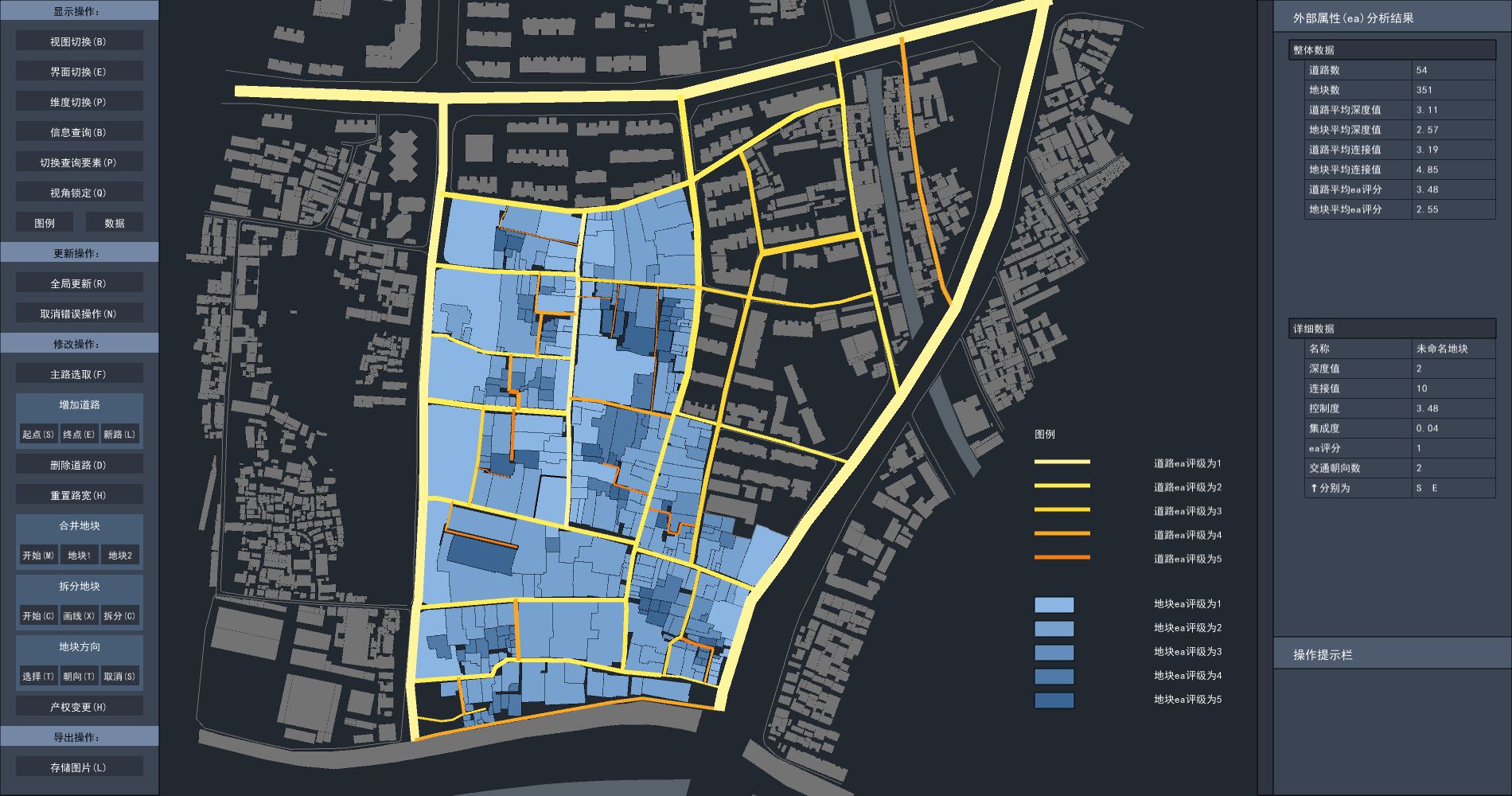历史地段多尺度层级结构数字化建构方法与解析应用——以南京荷花塘历史文化街区为例
Digital Construction Method and Analytical Application of Multi-scale Hierarchical Structure in Historic Areas: Case Study of Hehuatang Historical and Cultural Block in Nanjing
Citation
宋哲昊.历史地段多尺度层级结构数字化建构方法与解析应用[D].东南大学,2022.
Sources
PDF
摘要
历史地段能够真实地反映一个地区的传统风貌和地方特色,是城镇历史记忆的物质载体。当前的历史地段保护与更新方法在城市设计层面的讨论主要集中在以下两个方面:一是分级分段的保护机制难以通盘认知各空间要素间的连贯性和关联性,二是与历史地段保护更新相关的居民、政府、开发商等多元人群诉求难以协调,给实际操作带来困难。因此在历史地段保护更新过程中,设计师急需一个能够整合历史地段复杂的空间形态信息并明确其相互关系,同时反映多元人群诉求的高效分析与辅助决策工具。 中国历史地段的构成规则能够通过形态类型学领域多尺度层级的空间概念进行认知。而在中国历史地段保护与更新的历次实践中,基于微观空间元素的“小尺度、渐进式”的工作方法逐渐成为面对历史地段复杂问题的有效手段。两者分别从理论层面与实践层面印证了对于历史地段的认知、解析与保护、更新工作应从细微的空间元素入手,妥善考虑多尺度层级上的复杂信息并梳理其连接关系。随着信息技术的介入,数字驱动的解析方法以数据信息的递归建构起各尺度层级空间要素之间的整体关联,为相关研究提供了新的方法思路。 本文以南京荷花塘历史文化街区的保护与更新为主要研究对象,基于Java语言编程,探索了历史地段多尺度层级结构的数字化建构方法,并依托所构建的数学模型编写了设计决策辅助工具,在“小尺度、渐进式”的工作模式中辅助设计师应对复杂的空间形态与多元人群的诉求,完成设计决策。主要研究内容包括:以形态类型学的尺度层级框架为基础对中国历史地段的空间结构进行认知与解析;通过Java语言编程,建构反映历史地段多层级空间要素信息且能够对其进行形态解析的数学模型,完成将空间形态转化为数据集的过程;为数学模型添加可视化互动界面,构建可进行空间要素的修改并获得城市设计层面实时分析结果反馈的设计决策辅助工具;邀请相关专业设计师基于南京荷花塘历史文化街区的保护更新设计这一实际场景对该工具进行试用,验证该工具在实际工作中的应用价值及适用范围,并提出进一步优化改进方向。
关键词
历史地段、保护更新、形态类型学、尺度层级、数学模型、设计决策辅助工具
Abstract
Historic areas are the material carrier of the historical memory of a town, can truly reflect the traditional features and local characteristics of a region. At present, the discussion on the method of protection and renewal of historic areas in the field of urban design mainly focuses on the following two aspects. On the one hand, the hierarchical and segmented protection mechanism is difficult to fully understand the coherence and correlation between various spatial elements. On the other hand, it is difficult to coordinate the demands of diverse groups such as residents, government and developers, which brings difficulties to the actual operation. Therefore, in the process of protection and renewal of historic areas, designers need an efficient analysis and decision support tool which can integrate the complex spatial morphological information of historic areas and clarify their interrelations, while reflecting the demands of diverse groups of people. The compositional rules of Chinese historic areas can be recognized through the multi-scale hierarchical spatial concepts in the field of typo-morphology. In the previous practice of the protection and renewal of historic areas in China, the small-scale and gradual working method based on micro spatial elements has gradually become an effective means to face the complex problems of historic areas. Both of them confirm from the theoretical and practical levels that the cognition, analysis, protection and renewal of historic areas should start from small-scale spatial elements, properly consider complex information at multi-scale hierarchy and sort out their connections. With the intervention of information technology, the digital-driven analytical method constructs the overall relationship between spatial elements at various scales and levels through the recursion of data information, which provides new method ideas for related research. This paper takes the protection and renewal of Hehuatang historical and cultural block in Nanjing as the main research object, based on Java language programming, explores the digital construction method of the multi-scale hierarchical structure of historic areas, and creates a design decision support tool based on the mathematical model constructed. In the small-scale and gradual working method, this tool assists designers to deal with complex spatial forms and the demands of diverse groups of people, and complete design decisions. This research contents four items. Firstly, the spatial structure of Chinese historical areas is recognized and analyzed based on the scale and hierarchy framework of typo-morphology. Secondly, a mathematical model that can reflect the multi-level spatial element information of historic areas and can perform morphological analysis is constructed through Java language programming, the process of transforming the spatial morphology into a dataset is completed. Thirdly, visual interaction interface is added to the mathematical model, and a design decision support tool that can modify spatial elements and obtain feedback of real-time analysis results at the urban design level is constructed. Finally, this tool is tried by professional designers based on the actual scene of the protection and renewal design of Hehuatang historical and cultural block in Nanjing, the value and scope of application of the tool in practical work are verified, further optimization and improvement directions are obtained.
Keywords
Historic area, Protection and renewal, Typo-morphology, Hierarchical structure, Mathematical model, Design decision support tool



